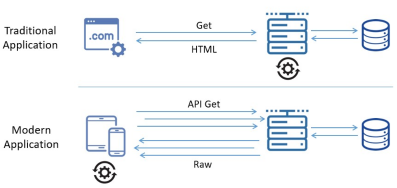API security is the prevention of unwanted or abusive usage of an API.
Challenges
In traditional web applications, data processing is done on the server side. Because of this, the entry points to the network architecture of the business were relatively few and straightforward to protect by setting up a web-application firewall (WAF) in front of the application server.
A foundational element of innovation in today’s app-driven world is the API. From banks, retail and transportation to IoT, autonomous vehicles and smart cities, APIs are a critical part of modern mobile, SaaS and web applications and can be found in customer-facing, partner-facing and internal applications. By nature, APIs expose application logic and sensitive data such as Personally Identifiable Information (PII) and because of this have increasingly become a target for attackers.

Taking into consideration that more and more applications use APIs to send and receive data and also the emerging micro-services architectures, the attack surface has expanded significantly. Because of that a new set of strategies and solutions need to be implemented to address the API security.

How can this technology help you?
Most common API attacks (OWASP Top 10 API Attacks):
Broken Object Level Authorization
APIs tend to expose endpoints that handle object identifiers, creating a wide attack surface Level Access Control issue.
Broken User Authentication
Authentication mechanisms are often implemented incorrectly, allowing attackers to compromise authentication tokens or to exploit implementation flaws to assume other user’s identities temporarily or permanently.
Excessive Data Exposure
Looking forward to generic implementations, developers tend to expose all object properties without considering their individual sensitivity, relying on clients to perform the data filtering before displaying it to the user.
Lack of Resources & Rate Limiting
Quite often, APIs do not impose any restrictions on the size or number of resources that can be requested by the client/user. Not only can this impact the API server performance, leading to Denial of Service (DoS), but also leaves the door open to authentication flaws such as brute force.
Broken Function Level Authorization
Complex access control policies with different hierarchies, groups, and roles, and an unclear separation between administrative and regular functions, tend to lead to authorization flaws.
Mass Assignment
Binding client provided data (e.g., JSON) to data models, without proper properties filtering based on a whitelist, usually lead to Mass Assignment. Either guessing objects properties, exploring other API endpoints, reading the documentation, or providing additional object properties in request payloads, allows attackers to modify object properties they are not supposed to.
Security Misconfiguration
Security misconfiguration is commonly a result of unsecure default configurations, incomplete or ad-hoc configurations, open cloud storage, misconfigured HTTP headers, unnecessary HTTP methods, permissive Cross-Origin resource sharing (CORS), and verbose error messages containing sensitive information.
Injection
Injection flaws, such as SQL, NoSQL, Command Injection, etc., occur when untrusted data is sent to an interpreter as part of a command or query.
Insufficient Logging & Monitoring
Insufficient logging and monitoring, coupled with missing or ineffective integration with incident response, allows attackers to further attack systems, maintain persistence, pivot to more systems to tamper with, extract, or destroy data.
Improper Assets Management
APIs tend to expose more endpoints than traditional web applications, making proper and updated documentation highly important.
Advantages
API Security solutions allow organization to implement the recommended best practices:







